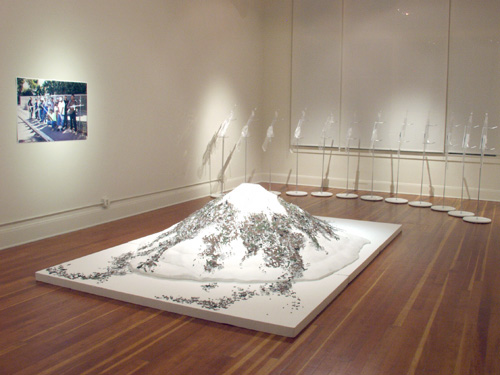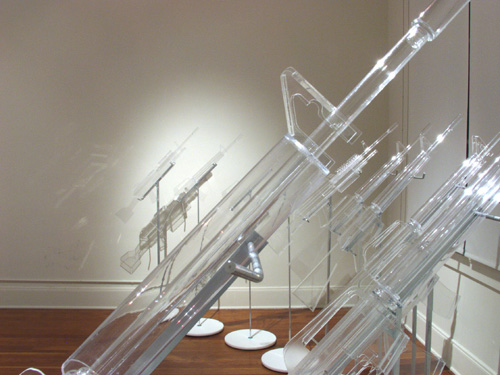Happy Pack
Installation, Sculpture, and Photography
Studio Islander: Mayumi Hamanaka and Taro Hattori
September 11th - October 2nd, 2004

2111 Mission Street
Suite 401
San Francisco 94110
510.467.4818
info@mission17.org
Happy Pack
Installation, Sculpture, and Photography
Studio Islander: Mayumi Hamanaka and Taro Hattori
September 11th - October 2nd, 2004

Happy Pack raises questions concerning violence, group formation, and national identity.
Taro Hattori has constructed twelve plastic machine guns (M-16s and M-249s), and hired day-laborers to pose with them for photographs. The transparency of the guns subverts the sense of power they otherwise evoke, and presents the authority of brute force in its meaninglessness. By hiring his models, Hattori mimics the growing importance of mercenaries in modern warfare, and the constitution of the American military in particular as a ‘volunteer’ army comprised largely of poor and working-class people – like these day laborers – without many viable alternatives. By constructing groups of twelve, he also draws a connection to America’s jury system that grants a more ambivalent significance to the formation of groups than his critique of violence might otherwise suggest. Uniformly armed, Hattori’s subjects appear to be united in a common purpose: to fight the “enemy,” to pass judgment, or simply to have their picture taken. But he has not instructed his models how to pose, and they do not stand in formation. The day-laborers strike poses rich with bravado that express not only the feelings of power that come with joining a group and carrying a gun, but also their individuality. The group is not internally cohesive, which both helps to explain the need for an excluded ‘other’ to hold groups together, and presents a critical vantage from which to challenge their force.
For her contribution to the show, Mayumi Hamanaka has built a 12’ x 8’ x 3’ replica of Mount Fuji and decorated it with green, brown, and grey pieces of felt cut from the pattern of the Japanese army’s camoflage uniform. While the colors of the camoflage resemble the rocks and trees of the landscape, the pieces of felt also have been pinned to the mountain approximately in shape of soldiers’ torsos, provoking consideration of the relationship between landscape, militarism, and the sense of both national and personal identity. Hamanaka constructed the piece in response to the recent mobilization of the Japanese army for its first foreign combat since WWII in Iraq. The work raises questions about the significance of Japan’s involvement in this war as an instrument of American interests, along with inviting consideration of unresolved legacies of Japanese imperialism in the first half of the twentieth-century. The intimacy between the landscape and the figures recalls racist mythologies from both Asia and Europe of authentic national identities rooted in blood and soil. And, in its diminished scale, Hamanaka presents Mount Fuji as a national symbol verging on kitsch. The installation questions the role of the military in defining a nation, and the power of war to give meaning to our lives. In its dissection of the camoflage pattern, it also provokes consideration of the tension between the individual and the group as a whole.



"Happy Pack," Alison Bing, SF Gate, September, 2004